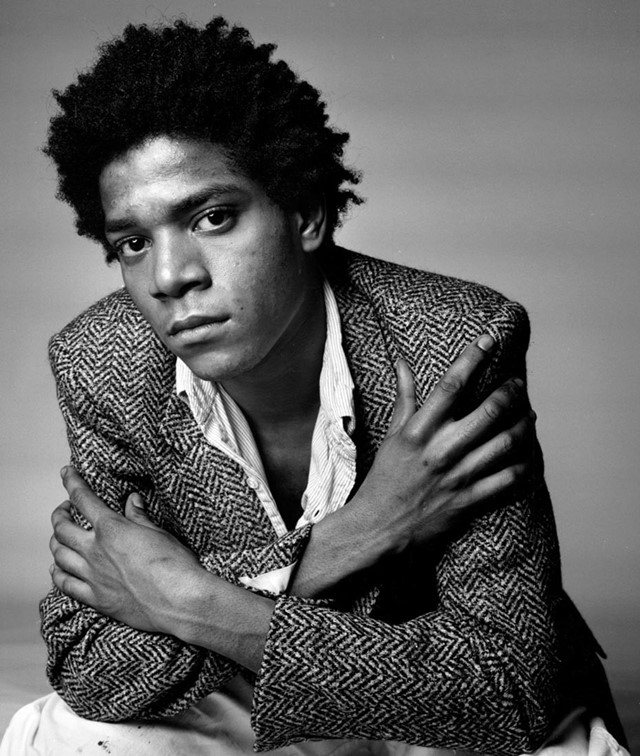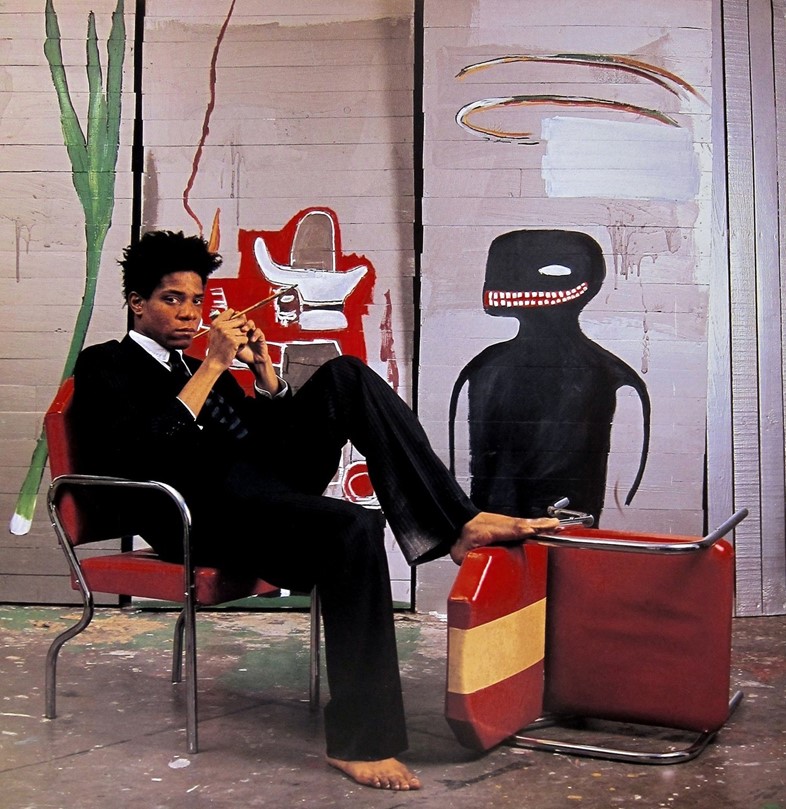Guided by a collection of his own quotes, we unpick the life, work, and legacy of the late artist
Almost three decades since his passing, Jean-Michel Basquiat’s work remains a permanent fixture in our art consciousness. Continually celebrated in his native North America, this year, the UK got its first ever major Basquiat exhibition at the Barbican – bringing interest in the late artist to fever-pitch. This Thursday, Dazed hosts a special Basquiat and Black Masculinity event at Shoreditch’s Ace Hotel. To bring you up to scratch, we talk you through Basquiat’s life including his childhood, trajectory, technique, relationships and subjective anxieties, as narrated by the artist himself.
“I never went to an art school. I failed the art courses that I did take in school. I just looked at a lot of things. And that’s how I learnt about art, by looking at it.”
Basquiat didn’t receive a formal art education, instead, he taught himself from alternative means. Inspired by television cartoons, he began drawing at an early age on sheets of paper that his father, Gerard Basquiat, would bring home from his accounting job. Basquiat’s last attempt at schooling was at the progressive City as School in Brooklyn where he illustrated a school paper named Basement Blues Press (alongside friend and fellow artist, Al Diaz) and entertained thoughts of becoming a cartoonist. Basquiat would also learn from observing paintings at art-museums that he frequented, especially with friend and collaborator Fab 5 Freddy, who recently shared memories of the times the pair spent pretending to be art students and visiting Caravaggio paintings at The Met.
“I'd say my mother gave me all the primary things. The art came from her.”
Basquiat’s mother, Matilde Andradas, had a strong influence on his creativity by constantly encouraging him to pursue his artistic talent. She also had a keen interest in fashion and sketching. She would frequently draw with Basquiat and often took him to visit The Brooklyn Museum, MoMA, and The Met.
“I left home at 15, and went to Washington Square Park. I just sat there dropping acid .... Now that all seems boring; it eats your mind up.”
Basquiat’s renegade streak started early. At 15, he ran away from home and slept on park benches in Tompkins Square Park, New York. After a week, he was arrested and returned to his father. At age 17, he dropped out of school for allegedly throwing a creampie in the principal’s face.
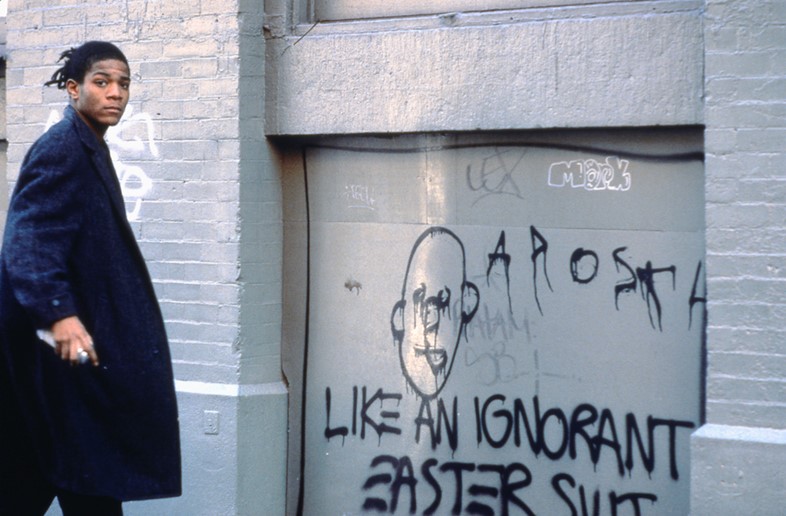
“Samo meant same old shit... It was kind of sophomoric. It was supposed to be a logo, like Pepsi.”
After dropping out of school, Basquiat began writing cryptic, poetic messages and drawing odd symbols across New York with a friend named Al Diaz. They formed the street-art collective SAMO©: an acronym for ‘Same Old Shit’ that the pair would tag their street pieces with. Basquiat conceptualised the pseudonym SAMO© while working on a piece for Basement Blues Press. The comic was about a young character searching for truth and spirituality, but who instead meets a false priest who attempts to sell him different types of religion: Judaism, Catholicism, and Buddhism. Finally, the pseudo-religion SAMO takes hold of the character who lives under the dictum: “SAMO is everything, everything is SAMO. SAMO, the religion without guilty and much more.”
At an expediential speed, SAMO© transformed from a lifestyle, a liberal religion, to an artistic experimentation in symbolism and semiotics as Basquiat and Diaz constructed their own slogans and spray painted them across the city. The pair wanted to address the issues of materialism and used SAMO© to fulfill the values they believed their society lacked, with a special focus on the elitism of the art world. Some of their slogans read: “SAMO© as an alternative 2 playing art with the ‘radical chic’ set on Daddy’s $funds... SAMO© is an end 2 confining art terms... Riding around in Daddy’s convertible trust fund company.”
In 1978, Diaz and Basquiat, sold their story to the Village Voice for $100 each. The article broke their anonymity and not long after, Basquiat began to identify as SAMO©, the person. “SAMO© is dead” began appearing around New York and the duo fell out for the next two years.
“I didn’t know it was a piss painting”
Andy Warhol was a huge turning point in Basquiat’s career. The pair met when Basquiat, a huge fan, saw Warhol dining in a New York restaurant with curator Henry Geldzahler in 1979. He introduced himself and sold Warhol a few of his postcards. For many in the art world, the relationship seemed odd, but it was symbiotic; Basquiat gave Warhol a new energy and youthfulness, and Warhol gave Basquiat new status and a fresh crowd. However, many recall a genuine platonic adoration between the pair. In this quote, Basquiat references the only painting he had in his apartment in 1982 that wasn’t his own. It was a portrait of Basquiat by Warhol, silkscreened on a background of splotched greeny gold. It was one of Warhol’s notorious 'piss paintings': abstracts created by mixing urine and copper sulfate on canvas. The pair fell out after the combined their talents for the exhibition Warhol/Basquiat Paintings in 1985, which was slated by the press, who referred to Basquiat as Warhol’s sidekick. When Warhol died from surgery complications in 1987, Basquiat was devastated. The pair never managed to rekindle their bond.
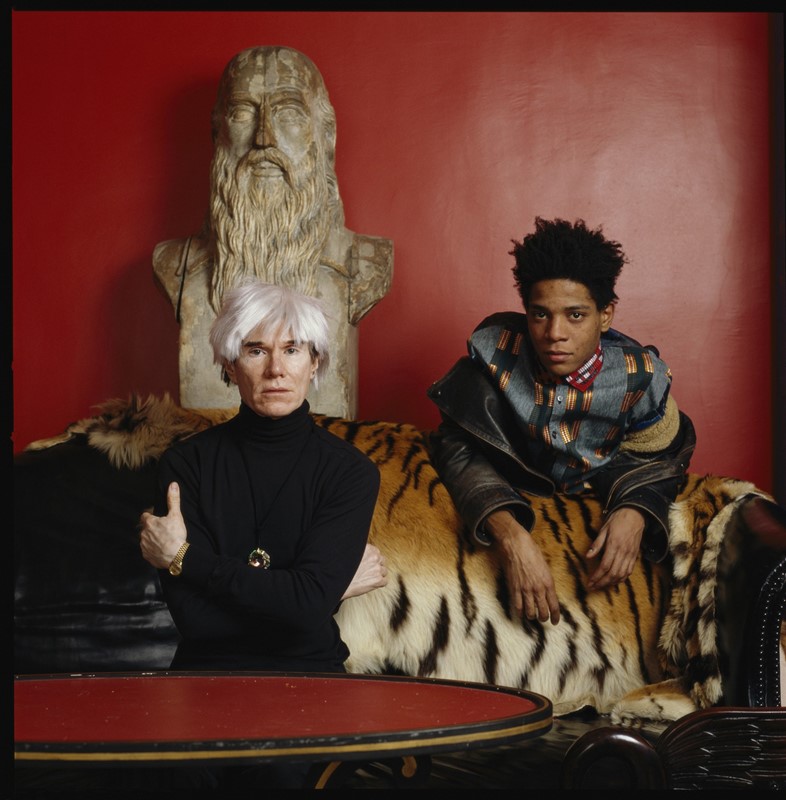
“Papa,” his father recalls him saying, “I've made it.”
In March 1982, Basquiat had his first solo exhibition at the Annina Nosei Gallery in New York after Basquiat caught Nosei’s eye at the New York/New Wave exhibition organised by Diego Cortez at MoMA PS1 gallery in 1981. Paintings he submitted to the show included “Arroz con Pollo”, “Self-Portrait, Untitled (Per Capita)”, and “Untitled (Two Heads on Gold)”. The exhibition was a huge success and his paintings sold between $10,000 to $25,00 each. The morning after the opening, Basquiat hired a limousine, drove to his dad’s house in Brooklyn, hugged and kissed him and gave him a handful of bills for one of his sisters, clearly overwhelmed by his own success.
“I was a really lousy artist as a kid. Too abstract expressionist, or I’d draw a ram’s head, really messy. I’d never win painting contests. I remember losing to a guy who did a perfect Spiderman.”
Basquiat’s work revolutionised the art world. When he started his career Minimalism was king but the success of his primitive and neo-expressionist style gave the art world new life and changed artistic perceptions of what could be considered art. His successful trajectory as someone who wasn’t formally art trained also changed traditional ideas of who and what constituted an artist.
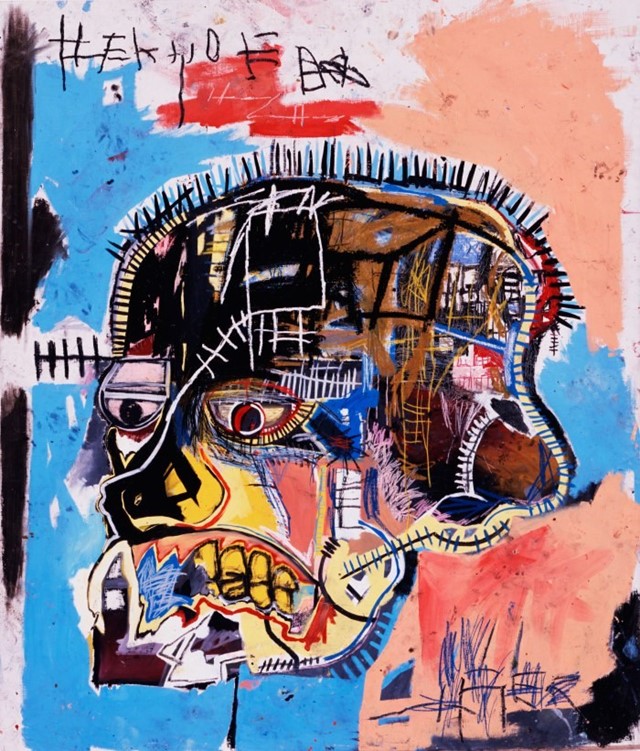
“I want to make paintings that look as if they were made by a child.”
Basquiat once told Fab 5 Freddy that a defining element of his work is his love for childhood cartoons and the frantic nature of being a kid: an energy that is consistently reflected in his paintings, and often spoke of how he admired the artwork of children more than the elitist art world.
Basquiat’s work is a crucial part of the Neo-Expressionist movement – an art movement defined by an intense deliberation with subjectivity, a rough handling of materials, expressive brushwork and intense colour. Basquiat’s technique shows itself in his brutal, raw depiction of subjects and themes, and an unforgiving commitment to using this technique to overthrow art world standards. Take “Untitled” (1982), for example. The piece takes a raw, yet personal subject of the skull and renders it with heavily applied paint and frantic, sprawling lines that create an intense energy. “Untitled” (1982) also shows us one of Basquiat’s most recurring motifs; the skull.
Basquiat held an intense obsession with limbs which began when his mum gifted him the book Gray’s Anatomy after he was hit by a car. The crown is another key motif, which he employed to honour the majesty of his heroes: groundbreaking Black athletes, musicians, and writers. He also used the crown in his self-portraits.
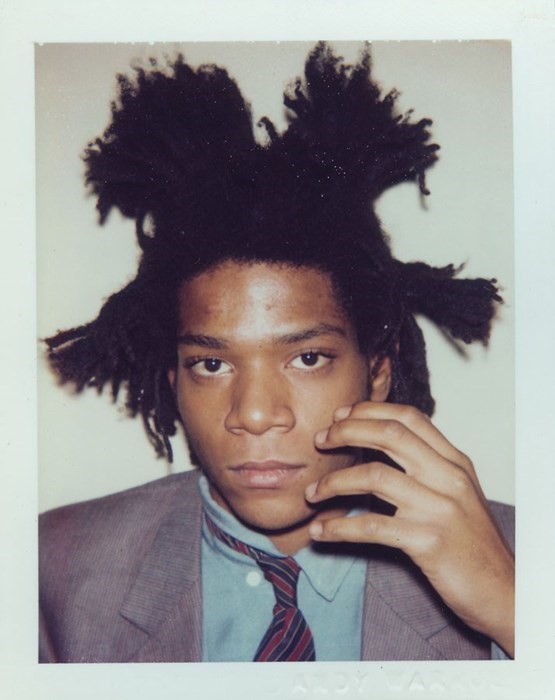
“Hollywood Africans in front of the Chinese theatre with footprints of movie stars”
Primitivism was also very present in Basquiat’s work, something he reclaimed from the appropriation of African cultures by many artists who came before him. While the primitive movement before him saw Western artists ‘borrow’ from non-Western culture and histories, Basquiat’s primitivism enabled him to address issues of race and class in his reality. He was extremely fascinated by African-American history and the many events that informed America’s Civil Rights Movement. Basquiat addresses these ideas in his work, combining them with the battle against the racism of his 70s-80s American context. In many of his pieces, Basquiat criticises abuses of power by authority, by depicting scenes of police violence especially in his piece “The Death of Michael Stewart” (1983). Realising Black people were missing from American art history, Basquiat painted his heroes, using their figures and words, often placing his signature crown on the canvas with them.
“I cross out words so you will see them more; the fact that they are obscured makes you want to read them.”
Basquiat’s works are loaded with symbolism. Just like André Breton’s Surrealist poetry, the artist used language to employ a child-like automatism as he took everyday phrases and turned them into cryptic poetry. Slogans like those found on “Onion Gum” (1983) are amplified by absurd repetition or obscured by the artist’s decision to cross them out and drawing even more attention to them. The linguistic elements of Basquiat’s works offer us a window into his mind as he questioned his surroundings. As noted by gallery owner, Jeffrey Deitch, “Basquiat’s canvases are aesthetic dropcloths that catch the leaks from a whirring mind. He vacuums up cultural fall-out and spits it out on the stretched canvas, disturbingly transformed.”
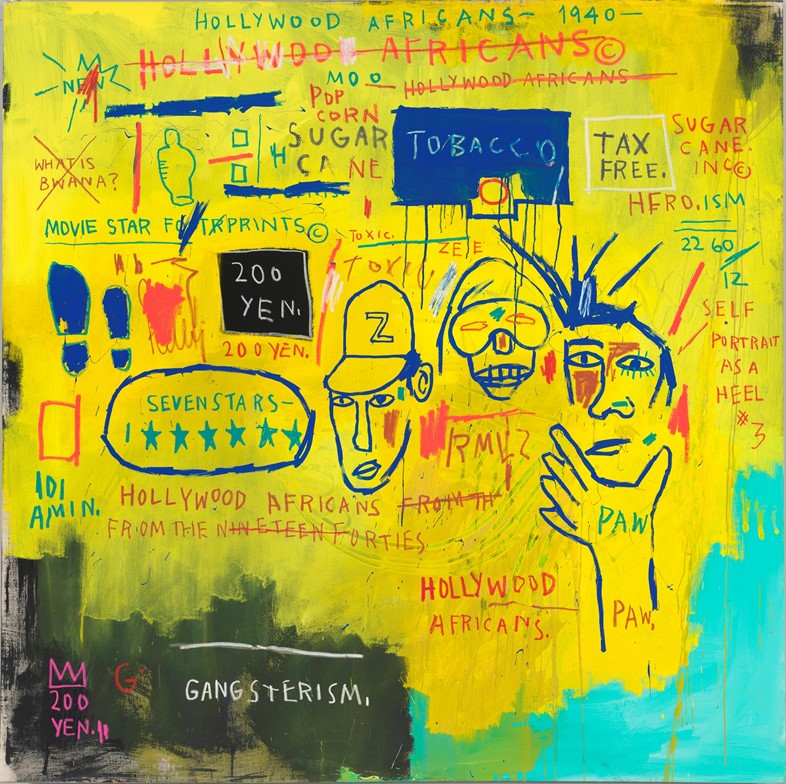
“Only one thing worries me,” he had told his father. “Longevity.”
According to Basquiat’s father, despite the artist’s success, he was constantly plagued by anxiety and an irrational fear of becoming irrelevant. After a rapid rise to success at such a young age, Basquiat grew increasingly paranoid that his luck was more of a fluke. When he and Warhol’s collaborative show, Warhol/Basquiat Paintings, at Tony Shafrazi in 1984 was rejected by wider art circles and critics – as referenced above – Basquiat’s fear was exacerbated.
“It could have been me, it could have been me”
This quote is Basquiat on the 1983 death of fellow artist and New York graff king, Michael Stewart. Basquiat was shaken to hear the news that Stewart was beaten to death by New York City police. Seeing his own life reflected in the death of a fellow artist, Basquiat went on to create “Defacement (The Death of Michael Stewart)”, not only to commemorate the young man's death but also to challenge the state-sanctioned brutality that men of color could face for pursuing their art in public spaces.
“I gotta get out of New York; I hate it. There's no heroin (in Hawaii), and it's so beautiful you don't even think about it.”
Despite Basquiat’s incredible success, his career was paralleled by a heavy drug addiction. In this quote, Basquiat told Vincent Gallo of his desires to escape to Hawaii in an attempt at sobriety. Basquiat made it to Hawaii, but upon his return to New York the artist died in his studio of a heroin overdose on August 12, 1988. He was only 27-years-old. Almost three decades on, Jean-Michel Basquiat’s legacy survives powerfully.
